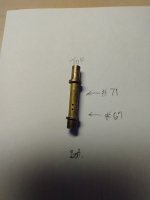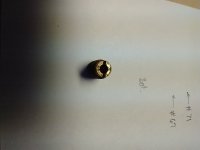DPDISXR4Ti
Member
- Joined
- Dec 12, 2017
- Threads
- 5
- Messages
- 33
Thanks for the feedback - you were both correct!
The main jet was clogged - couldn't even see through it once I got it out, which was not too easy to do. Initially it unscrews easily from the bottom of the carb (after removing the bowl), but then it just spins. You need to have a very light touch with the screwdriver after unscrewing for a bit, then the jet drops down a bit before catching another set of threads to finish unscrewing all the way out.
All of my carb cleaning tools were too big, so I just used a needle to clean out the orifice in the jet. Then it was easy to screw back in and reassemble everything. In hindsight, the jet didn't need to come all the way out - I could have cleaned it in place - I'll know better next time.
I'll paste below the comments I found on another forum, just to have another's perspective....
rotti1968 wrote...
certified Honda mechanic here, your main jet is clogged along with one or all three of the transition holes in the venturi . remove the carburetor, remove the bowl and down the center of the carb is your main jet unscrew that being careful not to damage it, clean with what works the best is a welding tip cleaner . then looking into the throat of the carb on the throttle side you will see three small holes, one or all three may or are clogged you can also use the tip cleaner here but be very careful not to break it off in one of the holes, then soak in carb cleaner. if after all of this you put it back together and it still runs only on choke put a new carb on it....
The main jet was clogged - couldn't even see through it once I got it out, which was not too easy to do. Initially it unscrews easily from the bottom of the carb (after removing the bowl), but then it just spins. You need to have a very light touch with the screwdriver after unscrewing for a bit, then the jet drops down a bit before catching another set of threads to finish unscrewing all the way out.
All of my carb cleaning tools were too big, so I just used a needle to clean out the orifice in the jet. Then it was easy to screw back in and reassemble everything. In hindsight, the jet didn't need to come all the way out - I could have cleaned it in place - I'll know better next time.
I'll paste below the comments I found on another forum, just to have another's perspective....
rotti1968 wrote...
certified Honda mechanic here, your main jet is clogged along with one or all three of the transition holes in the venturi . remove the carburetor, remove the bowl and down the center of the carb is your main jet unscrew that being careful not to damage it, clean with what works the best is a welding tip cleaner . then looking into the throat of the carb on the throttle side you will see three small holes, one or all three may or are clogged you can also use the tip cleaner here but be very careful not to break it off in one of the holes, then soak in carb cleaner. if after all of this you put it back together and it still runs only on choke put a new carb on it....


